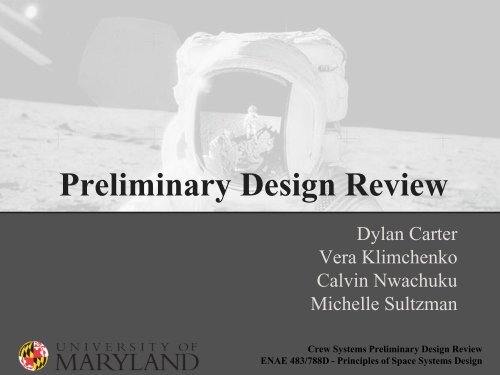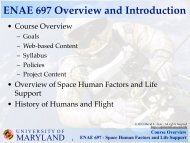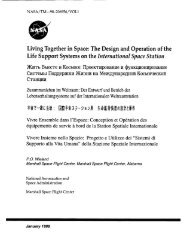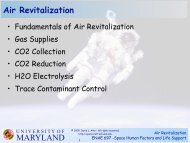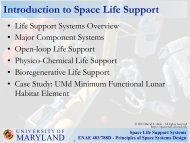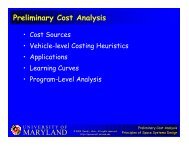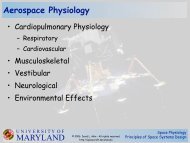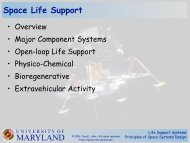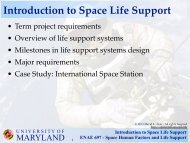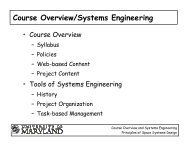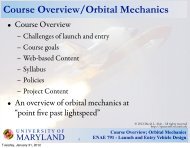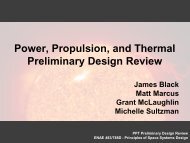Preliminary Design Review - University of Maryland
Preliminary Design Review - University of Maryland
Preliminary Design Review - University of Maryland
You also want an ePaper? Increase the reach of your titles
YUMPU automatically turns print PDFs into web optimized ePapers that Google loves.
<strong>Preliminary</strong> <strong>Design</strong> <strong>Review</strong><br />
Dylan Carter<br />
Vera Klimchenko<br />
Calvin Nwachuku<br />
Michelle Sultzman<br />
Crew Systems <strong>Preliminary</strong> <strong>Design</strong> <strong>Review</strong><br />
ENAE 483/788D - Principles <strong>of</strong> Space Systems <strong>Design</strong>
Mission Overview<br />
• <strong>Design</strong> a crewed spacecraft for a low-cost mission to<br />
the Moon<br />
• Support a crew <strong>of</strong> three for a 10 day mission with 3<br />
days <strong>of</strong> contingency<br />
• Maximum spacecraft diameter: 3.57 m<br />
• Half cone angle: 25° < θ < 32.5°<br />
• Wall thickness: 10 cm<br />
• Total mass allocation for crew and crew systems:<br />
1500 kg<br />
Crew Systems <strong>Preliminary</strong> <strong>Design</strong> <strong>Review</strong><br />
ENAE 483/788D - Principles <strong>of</strong> Space Systems <strong>Design</strong>
Choosing Optimal Half-Cone Angle<br />
Crew Systems <strong>Preliminary</strong> <strong>Design</strong> <strong>Review</strong><br />
ENAE 483/788D - Principles <strong>of</strong> Space Systems <strong>Design</strong>
Choosing Optimal Half-Cone Angle<br />
25 degree half-cone angle:<br />
• Provides most cabin volume (13.86 m 3 )<br />
• Provides large height (need at least 2 m clearance<br />
for cabin alone)<br />
• Cabin volume is scarce here<br />
Crew Systems <strong>Preliminary</strong> <strong>Design</strong> <strong>Review</strong><br />
ENAE 483/788D - Principles <strong>of</strong> Space Systems <strong>Design</strong>
Heat Shield Radius<br />
• Standard sphere-cone heat shields have halfangles<br />
around 70°<br />
• Chose radius <strong>of</strong> curvature that best approximated<br />
this shape<br />
• R = 2.777 m<br />
Crew Systems <strong>Preliminary</strong> <strong>Design</strong> <strong>Review</strong><br />
ENAE 483/788D - Principles <strong>of</strong> Space Systems <strong>Design</strong>
Atmosphere<br />
Constraints on Cabin Conditions:<br />
• R < 1.6 to reduce risk <strong>of</strong> DCS<br />
• Ambient O2 < 30% to reduce risk <strong>of</strong> fire<br />
• Stay within hypoxic and toxic boundaries<br />
Our <strong>Design</strong>:<br />
• Pressure = 9.5 psi<br />
• Ambient O2 = 29%<br />
• Reduces DCS risk as much as possible while<br />
avoiding flammability and hypoxia<br />
Crew Systems <strong>Preliminary</strong> <strong>Design</strong> <strong>Review</strong><br />
ENAE 483/788D - Principles <strong>of</strong> Space Systems <strong>Design</strong>
Atmosphere<br />
Crew Systems <strong>Preliminary</strong> <strong>Design</strong> <strong>Review</strong><br />
ENAE 483/788D - Principles <strong>of</strong> Space Systems <strong>Design</strong>
Denitrogenation<br />
Comparative DCS risk estimated using R value<br />
• Based on 60 minutes <strong>of</strong> prebreathe<br />
• R defined for 360-minute tissue<br />
Our <strong>Design</strong>: R = 1.20 (about 1.5% risk)<br />
• Compare to Shuttle: R = 1.10 (0.5% risk)<br />
• Large tissue choice makes this a very conservative estimate<br />
o For 200-minute model (next largest): R = 1.096<br />
o For 5-minute model (smallest): R = 0.0003<br />
Crew Systems <strong>Preliminary</strong> <strong>Design</strong> <strong>Review</strong><br />
ENAE 483/788D - Principles <strong>of</strong> Space Systems <strong>Design</strong>
Gasses Lost and Consumed<br />
Assume 10% <strong>of</strong> gas lost during depressurization<br />
4 days on surface: total 4 EVAs<br />
Cabin Interior: 13.86 m 3<br />
• Lost Gasses: 0.723 kg N 2, 0.338 kg O 2<br />
Oxygen Consumption: 1.11 kg O 2/day<br />
For 3 people over 13 days:<br />
• Consumed O 2: 43.29 kg O 2<br />
Crew Systems <strong>Preliminary</strong> <strong>Design</strong> <strong>Review</strong><br />
ENAE 483/788D - Principles <strong>of</strong> Space Systems <strong>Design</strong>
Oxygen Supply<br />
O 2 Consumed and Lost: 43.63 kg O 2<br />
Many options for oxygen production:<br />
• Open Loop (Non-regenerative)<br />
o O 2 tanks (gaseous or liquid)<br />
o Lithium Perchlorate (LiClO 4)<br />
o Lithium Superoxide (LiO 2)<br />
o Potassium Superoxide (KO 2)<br />
• Regenerative<br />
o Sabatier Reaction (requires some H 2 resupply)<br />
Crew Systems <strong>Preliminary</strong> <strong>Design</strong> <strong>Review</strong><br />
ENAE 483/788D - Principles <strong>of</strong> Space Systems <strong>Design</strong>
Oxygen Supply<br />
Crew Systems <strong>Preliminary</strong> <strong>Design</strong> <strong>Review</strong><br />
ENAE 483/788D - Principles <strong>of</strong> Space Systems <strong>Design</strong>
Oxygen Supply<br />
Gaseous and Liquid Storage are lightest<br />
• Gaseous requires no power<br />
• Liquid: 210 kJ/kg O 2 (8.16 W - very little) for<br />
vaporization<br />
Our <strong>Design</strong>: Open Loop with liquid O 2<br />
• Lowest mass and volume<br />
• Comparatively little power draw<br />
Liquid will also be used to store N 2<br />
Crew Systems <strong>Preliminary</strong> <strong>Design</strong> <strong>Review</strong><br />
ENAE 483/788D - Principles <strong>of</strong> Space Systems <strong>Design</strong>
Resupply Tank Properties<br />
Tank Mass: 0.7 kg/kg O 2, 0.8 kg/kg N 2<br />
• O 2 Tank Mass: 30.54 kg<br />
• N 2 Tank Mass: 0.579 kg<br />
Liquid O 2 Density: 1141 kg/m 3<br />
Liquid N 2 Density: 807 kg/m 3<br />
• O 2 Tank Volume: 0.0382 m 3<br />
• N 2 Tank Volume: 0.000896 m 3<br />
• Volume <strong>of</strong> tank material is negligible<br />
Crew Systems <strong>Preliminary</strong> <strong>Design</strong> <strong>Review</strong><br />
ENAE 483/788D - Principles <strong>of</strong> Space Systems <strong>Design</strong>
Depressurization Tank<br />
During cabin depressurization, ambient air is<br />
pumped into storage tank:<br />
• Stored at 3000 psi, 300 K<br />
• Masses: 10.61 kg air, 2 kg tank/kg O 2<br />
Depressurization Tank (and Pump, estimated):<br />
• Mass: 23.28 kg tank, 8.6 kg pump<br />
• Volume: 0.0439m 3 tank, 0.0093m 3 pump<br />
Crew Systems <strong>Preliminary</strong> <strong>Design</strong> <strong>Review</strong><br />
ENAE 483/788D - Principles <strong>of</strong> Space Systems <strong>Design</strong>
CO 2 Scrubbing<br />
95th percentile males produce 1.306 kg CO 2<br />
• 3.918 kg CO 2/day, 50.93 kg CO 2 total<br />
Options available for CO 2 removal:<br />
• LiOH Canisters<br />
• METOX Canisters w/ Oven<br />
• 4-Bed Molecular Sieves<br />
• Solid Amine Water Desorption<br />
• Sabatier Reaction<br />
Crew Systems <strong>Preliminary</strong> <strong>Design</strong> <strong>Review</strong><br />
ENAE 483/788D - Principles <strong>of</strong> Space Systems <strong>Design</strong>
CO 2 Scrubbing - Mass<br />
Crew Systems <strong>Preliminary</strong> <strong>Design</strong> <strong>Review</strong><br />
ENAE 483/788D - Principles <strong>of</strong> Space Systems <strong>Design</strong>
CO 2 Scrubbing - Power<br />
Crew Systems <strong>Preliminary</strong> <strong>Design</strong> <strong>Review</strong><br />
ENAE 483/788D - Principles <strong>of</strong> Space Systems <strong>Design</strong>
CO 2 Scrubbing<br />
METOX vs LiOH<br />
• METOX system lighter by about 10 kg<br />
• LiOH requires no power; METOX draws 1 kW<br />
• LiOH is smaller and more portable<br />
Our <strong>Design</strong>: Non-regenerable LiOH canisters<br />
• Difference in weight is outweighed by additional<br />
battery and portability<br />
Crew Systems <strong>Preliminary</strong> <strong>Design</strong> <strong>Review</strong><br />
ENAE 483/788D - Principles <strong>of</strong> Space Systems <strong>Design</strong>
CO 2 Scrubbing<br />
LiOH Canisters for CO 2 Scrubbing<br />
• 2.1 kg material/kg CO 2<br />
• 106.9 kg material minimum<br />
• Each canister is 6.4 kg: 17 total canisters<br />
17 canisters for total mass 108.8 kg<br />
Crew Systems <strong>Preliminary</strong> <strong>Design</strong> <strong>Review</strong><br />
ENAE 483/788D - Principles <strong>of</strong> Space Systems <strong>Design</strong>
Atmosphere <strong>Design</strong> Summary<br />
Cabin Conditions: 9.5 psi, 30% O 2, 70% N 2<br />
• Mass (air, tank, pump): 42.49 kg<br />
Supplementary O 2: Cryogenic liquid storage<br />
• Mass (O 2 and tank): 74.17 kg<br />
Supplementary N 2: Cryogenic liquid storage<br />
• Mass (N 2 and tank): 1.31 kg<br />
CO 2 Scrubbing: Expendable LiOH canisters<br />
• Mass (canisters): 108.8 kg<br />
Crew Systems <strong>Preliminary</strong> <strong>Design</strong> <strong>Review</strong><br />
ENAE 483/788D - Principles <strong>of</strong> Space Systems <strong>Design</strong>
Water<br />
Possible Options:<br />
Open-Loop System<br />
• Bring all necessary water in tanks<br />
without plan <strong>of</strong> recycling<br />
• Only extra mass is from pump<br />
• 48 W <strong>of</strong> power needed<br />
Recycling System<br />
• Vapor Compression Distillation<br />
System; bring less water and<br />
recycle 95% <strong>of</strong> water used daily.<br />
• Extra mass includes pump and<br />
distillation hardware<br />
• 648 W <strong>of</strong> power needed<br />
Crew Systems <strong>Preliminary</strong> <strong>Design</strong> <strong>Review</strong><br />
ENAE 483/788D - Principles <strong>of</strong> Space Systems <strong>Design</strong>
Water<br />
• Open-loop system requires more water.<br />
However, the most plausible water recycling<br />
system is very massive and large. It will also<br />
requires much more power.<br />
Crew Systems <strong>Preliminary</strong> <strong>Design</strong> <strong>Review</strong><br />
ENAE 483/788D - Principles <strong>of</strong> Space Systems <strong>Design</strong>
Water<br />
Crew Systems <strong>Preliminary</strong> <strong>Design</strong> <strong>Review</strong><br />
ENAE 483/788D - Principles <strong>of</strong> Space Systems <strong>Design</strong>
Water<br />
Chosen Water System: Open Loop<br />
o Less total mass for a short-term mission<br />
o More power, mass, and volume efficient<br />
Mass Breakdown:<br />
Water Mass: Potable Water - 2L/crew-day * 3 members * 13 days<br />
Total Water Mass = 190 kg<br />
Tank Mass =53 kg<br />
Hygiene Water - 2.84L/crew-day * 3 members * 10 days (nominal)<br />
Pump Mass = 8 kg<br />
Total Water System Mass: 251 kg<br />
+ 2.84L/crew-day * 3 members * 3 days (contingency)<br />
Crew Systems <strong>Preliminary</strong> <strong>Design</strong> <strong>Review</strong><br />
ENAE 483/788D - Principles <strong>of</strong> Space Systems <strong>Design</strong>
Food<br />
Using values from previous space shuttle missions,<br />
baseline requirements for the food system were<br />
determined:<br />
Crew Systems <strong>Preliminary</strong> <strong>Design</strong> <strong>Review</strong><br />
ENAE 483/788D - Principles <strong>of</strong> Space Systems <strong>Design</strong>
Food<br />
Using these baseline requirements, food and<br />
packaging mass over the duration <strong>of</strong> the mission<br />
was calculated:<br />
Crew Systems <strong>Preliminary</strong> <strong>Design</strong> <strong>Review</strong><br />
ENAE 483/788D - Principles <strong>of</strong> Space Systems <strong>Design</strong>
Food<br />
Cargo Transfer Bags (CTBs) will be used to stow<br />
food<br />
• To hold 58.67 kg need equivalent <strong>of</strong> 5 half-sized<br />
CTBs (0.12 m 3 )<br />
• Using two single-size CTBs for meals and snacks<br />
and one half-sized CTB for beverages<br />
Crew Systems <strong>Preliminary</strong> <strong>Design</strong> <strong>Review</strong><br />
ENAE 483/788D - Principles <strong>of</strong> Space Systems <strong>Design</strong>
Food<br />
No Thermostablized Meals<br />
• Eliminates mass and volume requirements <strong>of</strong><br />
oven<br />
• Over mission duration <strong>of</strong> 13 days will not cause<br />
morale or nutritional issues<br />
Crew Systems <strong>Preliminary</strong> <strong>Design</strong> <strong>Review</strong><br />
ENAE 483/788D - Principles <strong>of</strong> Space Systems <strong>Design</strong>
Other Food System Related Masses<br />
Food locker mass: 13.65 kg<br />
Trays and utensils: ~ 1 kg<br />
Hydration Station: ~ 15 kg<br />
Total Food System Mass: ~ 90 kg<br />
Crew Systems <strong>Preliminary</strong> <strong>Design</strong> <strong>Review</strong><br />
ENAE 483/788D - Principles <strong>of</strong> Space Systems <strong>Design</strong>
Waste Management<br />
• All <strong>of</strong> the waste produced during the mission will be<br />
collected, stabilized and stored<br />
• Recycling the waste products does not prove to be<br />
optimal for this short term mission due to the mass,<br />
power and space constraint<br />
• Human solid waste will go into the fecal bags and then<br />
into the fecal bag compartment<br />
• Urine and grey water will go into the Urine Collection<br />
and Transfer Device<br />
Crew Systems <strong>Preliminary</strong> <strong>Design</strong> <strong>Review</strong><br />
ENAE 483/788D - Principles <strong>of</strong> Space Systems <strong>Design</strong>
Breakdown <strong>of</strong> Waste<br />
Waste [kg/CM-d] [kg/3CM-13d] Storage<br />
Urine 1.562 60.9 Liquid Waste Tank<br />
Feces 0.123 4.8 Fecal Bag Collection<br />
Hygiene Water<br />
2.84<br />
110.8 Liquid Waste Tank<br />
Urine Flush Water 0.5 19.5 Liquid Waste Tank<br />
Food Packaging 0.324 12.6 Trash Bag<br />
Wet Wipes 0.051 1.9 Trash Bag<br />
Toilet Paper 0.028 1.09 Trash Bag<br />
Total Waste Mass (kg) 5.4 211.6 ***The food package, wet wipes and toilet paper<br />
mass will not be included in the final mass estimation<br />
because mass is already allocated for them in<br />
previous sections<br />
Crew Systems <strong>Preliminary</strong> <strong>Design</strong> <strong>Review</strong><br />
ENAE 483/788D - Principles <strong>of</strong> Space Systems <strong>Design</strong>
Human Solid Waste<br />
• Fecal matter will be collected into special fecal bags, similar to<br />
the ones used on Apollo module.<br />
• After the fecal matter is thoroughly mashed and compressed, the<br />
fecal bag will be treated with germicide and sealed. After all the<br />
procedures, it will be placed into a designated shoot leading to<br />
the fecal bag compartment.<br />
Crew Systems <strong>Preliminary</strong> <strong>Design</strong> <strong>Review</strong><br />
ENAE 483/788D - Principles <strong>of</strong> Space Systems <strong>Design</strong>
Human Solid Waste<br />
The fecal bag is able to hold about 0.0408 kg/bag.<br />
# <strong>of</strong> Bags= (0.123[kg/CM-d])*(3CM)*(13d)/(0.0408kg/bag)=118<br />
bags<br />
Assuming the density <strong>of</strong> water:<br />
Total Volume <strong>of</strong> the Bags=(118*0.0408)/1000=0.0048m 3<br />
The volume <strong>of</strong> the fecal bag compartment will be<br />
larger than the total volume <strong>of</strong> the bags by<br />
0.0002m 3 for storage space.<br />
FECAL BAG<br />
COMPARTMENT<br />
Aluminum Square Tank<br />
M=67 kg<br />
Side=.168 m<br />
Crew Systems <strong>Preliminary</strong> <strong>Design</strong> <strong>Review</strong><br />
ENAE 483/788D - Principles <strong>of</strong> Space Systems <strong>Design</strong>
Human Urine and Grey Water Collection<br />
Flush Water<br />
0.5 [kg/CM-d]<br />
6.5 [kg/CM-13d]<br />
Total Mass: 19.5 kg<br />
Total Volume=0.0195m 3<br />
Liquid Waste Tank<br />
Material: Aluminum<br />
Capacity: 0.0956m 3<br />
Wall Thickness: 2cm<br />
Used Hygiene Water<br />
2.84 [kg/CM-d]<br />
36.92[kg/CM-13d]<br />
Total Mass:110.8 kg<br />
Total Volume=0.1108 m 3<br />
Human urine and grey water will<br />
be collected in one spherical tank.<br />
Urine<br />
1.562 [kg/CM-d]<br />
20.31 [kg/CM-13d]<br />
Total Mass:60.9kg<br />
Total Volume: 0.0609 m 3<br />
2 Spherical Tanks<br />
Wall Thickness: 2cm<br />
Rinner=0.284m<br />
Router=0.304m<br />
Mass=60.48kg<br />
Crew Systems <strong>Preliminary</strong> <strong>Design</strong> <strong>Review</strong><br />
ENAE 483/788D - Principles <strong>of</strong> Space Systems <strong>Design</strong>
Trash<br />
• Wet wipes, food packaging and other<br />
consumables will be stowed away in wet and dry<br />
trash bags below the the first deck or above the<br />
first deck.<br />
• The food packaging might contain food leftovers<br />
and should be stowed away in durable wet bags<br />
that will not let out moisture or smells.<br />
Crew Systems <strong>Preliminary</strong> <strong>Design</strong> <strong>Review</strong><br />
ENAE 483/788D - Principles <strong>of</strong> Space Systems <strong>Design</strong>
Exterior <strong>Design</strong><br />
Crew Systems <strong>Preliminary</strong> <strong>Design</strong> <strong>Review</strong><br />
ENAE 483/788D - Principles <strong>of</strong> Space Systems <strong>Design</strong>
Interior Layout<br />
Upper Level<br />
Launch and Re-entry<br />
Control Console<br />
Launch Seats<br />
Crew/Space Suits<br />
Window<br />
Lunar Landing<br />
Control Console<br />
Tanks (Water,<br />
Waste, O 2, N 2,<br />
etc.)<br />
Crew Systems <strong>Preliminary</strong> <strong>Design</strong> <strong>Review</strong><br />
ENAE 483/788D - Principles <strong>of</strong> Space Systems <strong>Design</strong>
Interior Layout<br />
• Space suits will be worn during launch and stored in<br />
launch seats while not in use<br />
• Hammocks will be provided for crew to hang across<br />
cabin for sleeping arrangements<br />
• Upper level is provided as additional space for stowage<br />
• Bathroom area will be <strong>of</strong>f to the side opposite the airlock<br />
• Hammocks can be used as curtains during operational<br />
hours to provide privacy for bathroom area<br />
• Clothing, food, and other CTBs can be stored on shelving<br />
provided under lunar landing control console
Sight Line Analysis<br />
Crew Systems <strong>Preliminary</strong> <strong>Design</strong> <strong>Review</strong><br />
ENAE 483/788D - Principles <strong>of</strong> Space Systems <strong>Design</strong>
Ingress/Egress<br />
• A platform with a retractable ladder will sit just<br />
inside the airlock to be deployed when leaving the<br />
spacecraft.<br />
• There will be 4 EVAs during the missions,<br />
maximum <strong>of</strong> 8 hours each. One on each day spent<br />
on the moon. All the crew members will<br />
participate.<br />
Crew Systems <strong>Preliminary</strong> <strong>Design</strong> <strong>Review</strong><br />
ENAE 483/788D - Principles <strong>of</strong> Space Systems <strong>Design</strong>
Power Requirements<br />
O 2 and N 2 Vaporization: 8.3 W<br />
Vacuum Pump: 249 W<br />
Water Pump: 48 W<br />
Water Heater: 100 W<br />
Solid Waste Management Equipment: 16 W<br />
Max Power Draw: 421.3 W<br />
Crew Systems <strong>Preliminary</strong> <strong>Design</strong> <strong>Review</strong><br />
ENAE 483/788D - Principles <strong>of</strong> Space Systems <strong>Design</strong>
Total Mass<br />
Mass (kg)<br />
Initial Mass Estimate 1500<br />
Atmosphere Management 226.8<br />
Water Storage and Distribution 251<br />
Food Supplies 90<br />
Waste Management 190<br />
Equipment and Misc. Supplies<br />
Space Suits 300<br />
Clothing 43<br />
Crew 240<br />
Total Mass 1340.8<br />
Mass Margin (%) 10.61<br />
Crew Systems <strong>Preliminary</strong> <strong>Design</strong> <strong>Review</strong><br />
ENAE 483/788D - Principles <strong>of</strong> Space Systems <strong>Design</strong>
References<br />
• Advanced Life Support Baseline Values and Assumptions Document -<br />
NASA/CR—2004–208941 – NASA JSC, Aug. 2004<br />
• Advanced Life Support Baseline Values and Assumptions Document –<br />
JSC-47804 – JSC Crew and Thermal Systems Division, May 2002<br />
• Advanced Life Support Systems Requirements Document - JSC-38571,<br />
rev.B - JSC Crew and Thermal Systems Division, Sept. 2002<br />
• Akin, David L. "ECLIPSE: <strong>Design</strong> <strong>of</strong> a Minimum Functional Habitat for<br />
Initial Lunar Exploration.“ AIAA Space 2009 Conf. & Exposition (2009):<br />
n. pag. Print.<br />
• Akin, David. (2011) Habitability and Human Factors [PDF]. Retrieved<br />
from<br />
http://spacecraft.ssl.umd.edu/academics/483F12/483F12L12.hufac/483F12<br />
L12.hufacx.pdf<br />
Crew Systems <strong>Preliminary</strong> <strong>Design</strong> <strong>Review</strong><br />
ENAE 483/788D - Principles <strong>of</strong> Space Systems <strong>Design</strong>
References<br />
• Akin, David. (2012) Introduction to Space Life Support [PDF]. Retrieved from<br />
http://spacecraft.ssl.umd.edu/academics/483F12/483F12L11.life_support/483F<br />
12L11.life_support.pdf<br />
• Akin, David. (2012) Aerospace Physiology [PDF]. Retrieved from<br />
http://spacecraft.ssl.umd.edu/academics/483F12/483F12L10.physiology/483F1<br />
2L10.physiology.pdf<br />
• Bienh<strong>of</strong>f, Dallas G., Russell F. Graves, and Greg J. Gentry. "Lunar Habitat:<br />
Minimum Functionality to Outpost Capable." AIAA Space 2009 Conf. &<br />
Exposition (2009): n. pag. Print.<br />
• Jorgensen, Catherine A. Baseline <strong>Design</strong>. N.p.: n.p., 2000. Print. Vol. 1 <strong>of</strong><br />
Intern<br />
• Howe, Scott A., and Robert Howard. Duel Use <strong>of</strong> Packaging on the Moon:<br />
Logistics-2-Living. Rept. no. 6049. N.p.: AIAA, 2010. Print.ational Space<br />
Station Evolution Data Book.<br />
Crew Systems <strong>Preliminary</strong> <strong>Design</strong> <strong>Review</strong><br />
ENAE 483/788D - Principles <strong>of</strong> Space Systems <strong>Design</strong>
References<br />
• Human Integration <strong>Design</strong> Handbook (HIDH). WASHINGTON, DC:<br />
NASA, 2010. Print. NASA/SP-2010-3407.<br />
• Lin, John K. Lunar Surface Systems Concept Study: Minimum<br />
Functionality Habitat Element. N.p.: n.p., n.d. Print.<br />
• NASA. Advanced Life Support Research and Technology Development<br />
Metric. By Anthony J. Hanford. Technical rept. no. 213694. Houston:<br />
NASA, 2006. Print.<br />
• Rapp, Donald, “A <strong>Review</strong> <strong>of</strong>: Advanced Life Support Systems Integration,<br />
Mondeling, and Analysis Reference Missions Document.” Retrieved from<br />
http://spaceclimate.net/JSC.DRM.life.support.pdf<br />
• Rudisill, Mirianee, et al. Lunar Architecture Team-Phase 2 Habitat Volume<br />
Estimation "Caution When Using Analogs." Technical rept. N.p.: n.p., n.d.<br />
Print.<br />
Crew Systems <strong>Preliminary</strong> <strong>Design</strong> <strong>Review</strong><br />
ENAE 483/788D - Principles <strong>of</strong> Space Systems <strong>Design</strong>
References<br />
• Scheuring et. al, "Risk Assessment <strong>of</strong> Physiological Effects <strong>of</strong> Atmospheric<br />
Composition and Pressure in Constellation Vehicles" 16th Annual Humans in<br />
Space, Beijing, China, May 2007<br />
• Shull, Sarah, Raul Polit-Casillas, and Scott A. Howe. "NASA Advanced<br />
Exploration Systems: Concepts for Logistics to Living." AIAA Space 2012<br />
Conf. & Exposition (2012): 1-10. Print.<br />
• Strayer, Richard F., Mary E. Hummerick, and Jeffrey T. Richards.<br />
Characterization <strong>of</strong> Volume F Trash from Four Recent STS Missions. N.p.:<br />
n.p., n.d. Print.<br />
• United Space Alliance. Final Report on the 3-Month Alternate Access to<br />
Station Performance Requirements Study. Research rept. N.p.: n.p., 2002.<br />
Print.<br />
• <strong>University</strong> <strong>of</strong> <strong>Maryland</strong>. Space Systems Laboratory. Minimum Functionality<br />
Lunar Habitat Element. By David L. Akin. N.p.: n.p., 2009. Print.<br />
Crew Systems <strong>Preliminary</strong> <strong>Design</strong> <strong>Review</strong><br />
ENAE 483/788D - Principles <strong>of</strong> Space Systems <strong>Design</strong>
References<br />
• Vacuum Pump XE-225. 2012. Retrieved from http://www.made-inchina.com/showroom/ningboaux0574/productdetailNMLxmoITquVn/China-Vacuum-Pump-XE-225-.html<br />
Crew Systems <strong>Preliminary</strong> <strong>Design</strong> <strong>Review</strong><br />
ENAE 483/788D - Principles <strong>of</strong> Space Systems <strong>Design</strong>


